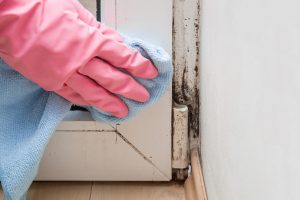There is no doubt that hidden dangers within a home will often cause the greatest concerns. One perfect example of this observation is dampness. A damp environment can lead to mould growth, it can exacerbate allergies and it can cause physical damage to materials such as wood and upholstery over time. This is why spotting the first signs of damp is crucial if you hope to avoid more serious issues in the future. Let us take a look at some telltale symptoms of this condition as well as a handful of the best ways to rid yourself of this potential nuisance.
Visual Cues
There are several signs that you need to address a moisture problem within your home. Perhaps the most common is the presence of discolourations on the floor, walls or ceiling. These stains may or may not be accompanied by blistering paint, soft plasterboard and peeling sections of wallpaper. You could also notice that mildew or mould is beginning to appear.
Another sign that is often indicative of an overly damp environment is a great deal of condensation on windows; even if these are double-glazed variants. Dampness will often cause the interior environment to cool and as a result, this condensation is more likely to occur. If you note that the levels of moisture seem to be higher in the basement, you may be suffering from what is known as rising damp. Once again, mould and stains might accompany this condition (although they may start at the floor before moving up). Other symptoms of rising damp include rotted skirting boards, tiles or grout that have become loose, brown or yellow lines on a wall, and an accumulation of a salt-like powder.

Odours and Other Hints
Signs of damp within your home might also come in the form of a musty or rotten smell. Carpets and textiles may also be affected. This can worsen existing issues such as allergies or respiratory problems; a very real concern if children or the elderly are present. The good news is that there are many ways to treat a damp environment and if you are able to take a proactive approach, the chances are high that it will be dealt with in a timely fashion. How can Treatex Wall Coatings help?
The Benefits of Damp Proofing External Walls
The most effective way to provide a damp-proof barrier within the home is through the use of cutting-edge wall coatings that are intended to offer an impermeable membrane between internal rooms and the outside environment. There are several methods which can be used. These may include:
- The application of exterior wall coatings.
- The injection of a substance known as Dry Zone to fill any small voids or cracks.
- Using hydraulic lime cement when dealing with masonry.
- Protecting brickwork with a clear damp-proof coating.
Of course, the exact method will depend upon the home in question as well as the extent of the condition itself. This is why Treatex Wall Coatings offers a number of targeted solutions when damp proofing external walls. Our company possesses more than 20 years of experience and we work with the best materials in the industry. You can therefore remain assured that quality is never a concern.
Simply ignoring a damp environment will not correct the issue. If you suspect that a problem may be present, please contact us on 0800 999 2932.
